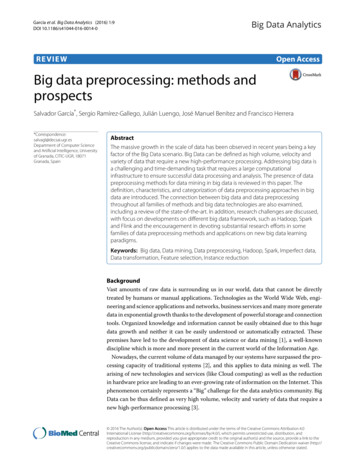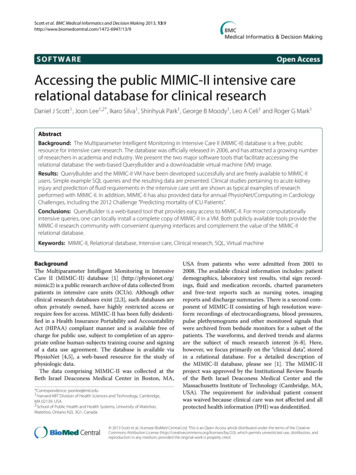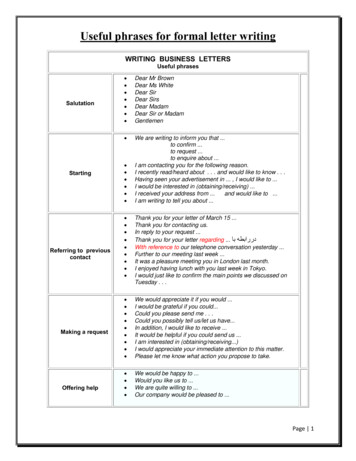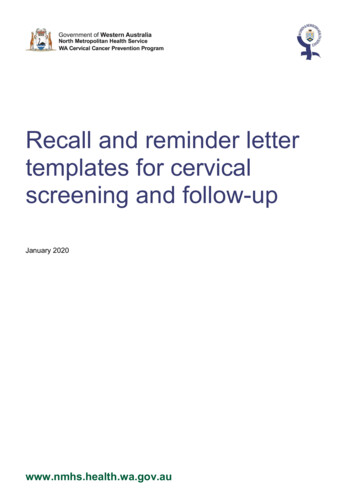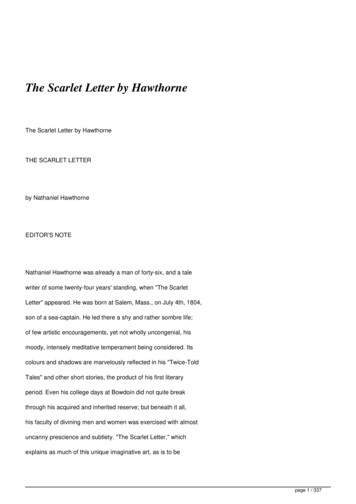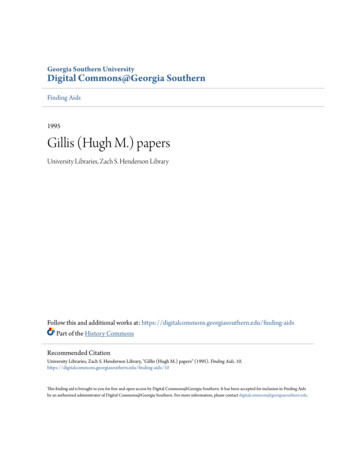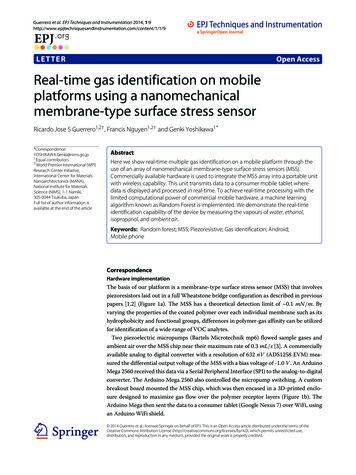
Transcription
Guerrero et al. EPJ Techniques and Instrumentation 2014, content/1/1/9LET T EROpen AccessReal-time gas identification on mobileplatforms using a nanomechanicalmembrane-type surface stress sensorRicardo Jose S Guerrero1,2† , Francis Nguyen1,2† and Genki .jp† Equal contributors1 World Premier International (WPI)Research Center Initiative,International Center for MaterialsNanoarchitectonics (MANA),National Institute for MaterialsScience (NIMS), 1-1 Namiki,305-0044 Tsukuba, JapanFull list of author information isavailable at the end of the articleAbstractHere we show real-time multiple gas identification on a mobile platform through theuse of an array of nanomechanical membrane-type surface stress sensors (MSS).Commercially available hardware is used to integrate the MSS array into a portable unitwith wireless capability. This unit transmits data to a consumer mobile tablet wheredata is displayed and processed in real-time. To achieve real-time processing with thelimited computational power of commercial mobile hardware, a machine learningalgorithm known as Random Forest is implemented. We demonstrate the real-timeidentification capability of the device by measuring the vapours of water, ethanol,isopropanol, and ambient air.Keywords: Random forest; MSS; Piezoresistive; Gas identification; Android;Mobile phoneCorrespondenceHardware implementationThe basis of our platform is a membrane-type surface stress sensor (MSS) that involvespiezoresistors laid out in a full Wheatstone bridge configuration as described in previouspapers [1,2] (Figure 1a). The MSS has a theoretical detection limit of 0.1 mN/m. Byvarying the properties of the coated polymer over each individual membrane such as itshydrophobicity and functional groups, differences in polymer-gas affinity can be utilizedfor identification of a wide range of VOC analytes.Two piezoelectric micropumps (Bartels Microtechnik mp6) flowed sample gases andambient air over the MSS chip near their maximum rate of 0.3 mL/s [3]. A commerciallyavailable analog to digital converter with a resolution of 632 nV (ADS1258 EVM) measured the differential output voltage of the MSS with a bias voltage of -1.0 V . An ArduinoMega 2560 received this data via a Serial Peripheral Interface (SPI) to the analog-to-digitalconverter. The Arduino Mega 2560 also controlled the micropump switching. A custombreakout board mounted the MSS chip, which was then encased in a 3D-printed enclosure designed to maximize gas flow over the polymer receptor layers (Figure 1b). TheArduino Mega then sent the data to a consumer tablet (Google Nexus 7) over WiFi, usingan Arduino WiFi shield. 2014 Guerrero et al.; licensee Springer on behalf of EPJ. This is an Open Access article distributed under the terms of theCreative Commons Attribution License (http://creativecommons.org/licenses/by/4.0), which permits unrestricted use,distribution, and reproduction in any medium, provided the original work is properly credited.
Guerrero et al. EPJ Techniques and Instrumentation 2014, content/1/1/9Page 2 of 5OutsideMicrocontroller SignalAmbient AirISValtaMSSWiFi VMArduinoTabletMicropumpMicrocontroller SignalOutsideFigure 1 System components and operation. a) Image of MSS in a four sensor array configuration. EachMSS is coated with a different polymer exhibiting different gas interaction properties. b) The enclosurecontaining the MSS sensor array chip and its electrical connections. c) Components in the device and thedirections of information and gas flow between them. Information about the sample arrives at the tablet foranalysis.Data processingRandom Forests [4] allow short characterization times of arbitrary input; characterizationtime is tunable through the size of the Forest. Each Forest can be tailored to complete itstask on hardware of arbitrary speeds while maintaining a real-time analysis. Once generated offline, this machine learning algorithm can be moved to a target platform for quick,real-time analysis. Classification of data using a Random Forest simply involves traversalof many decision trees, which can be multithreaded easily for fast computation on multicore processors. While this approach is sometimes coupled with Principle ComponentAnalysis (PCA) to determine better candidates for predictors [5], the device is capable ofidentifying the chosen samples without requiring the full dataset in contrast to PCA. Voltage variations as a result of sample flowing through the device form unique curves whenmeasured over time. These curves have several identifying characteristics, which can beextracted quickly by splitting the input into several windows, obtaining the difference oftheir averages, and using these as predictors for the Random Forest analysis.The Random Forest was trained on sample data collected with the device using Scikitlearn [6] with Python 3.2. Converting the Forest into a custom, portable file format allowsa consumer handheld tablet to predict outcomes with the CPU to be the only limitingfactor in prediction speed.VerificationThe device was verified by identifying between ethanol, isopropanol, water, and ambientair. A training set consisting of 196 sample/purge cycles (48 cycles per sample type, and52 for ambient air) was used to train a 100 tree Random Forest. Though the ADS1258measured at a rate of 460 samples per second (SPS) per channel, data transmission was
Guerrero et al. EPJ Techniques and Instrumentation 2014, content/1/1/9Channel 1Page 3 of 5Channel 2Channel 3Channel 410Output (mV)86420-20500100015002000Data PointsFigure 2 Sample ethanol data. An example of measured data during read cycles. Ethanol was pumped tothe MSS on the first four segments (Sample point 0 to 1196) and ambient air was pumped to the MSS on thelatter four segments to purge the absorbed ethanol vapour.limited to 4800 bytes every 2 seconds (approximately 400 samples per second per channel)due to problems inherent within the Arduino WiFi module [7]. This caused the signal toappear discontinuous (Figure 2).The training data was found to be easy to differentiate as a series of slopes in a voltagevs time series. Since the signal was divided evenly into eight segments per purge/samplecycle, the slopes between the averages of each segment indicated the general trend of thecurve. Using these slopes as predictors for the Random Forest allowed the algorithm toidentify sample gases with a high degree of accuracy (Additional files 1, 2).The data classification technique traditionally performs well at avoiding overfitting oftraining data [4]. Using the out-of-bag estimator built-in to our Random Forest creationlibrary, the Forest scored approximately 0.939, representing a 93.9% accuracy in predictingoutcomes from inputs for which the Forest was not trained. The training set used to growEtOHIPAWatera)8Ambient Gas3Output (mV)Output (mV)106420 2b)210 105001000150020000500Data Points20c)Output (mV)Output (mV)0.2100015002000Data Points0 0.2 0.4 0.6d)151050 5050010001500Data Points20000500100015002000Data PointsFigure 3 Training data channel response. An overlay of all input data used as the training dataset. Eachgraph (a-d) corresponds to the data for one channel (1-4) on the MSS chip, while the colours correspond tothe analytes used.
Guerrero et al. EPJ Techniques and Instrumentation 2014, content/1/1/9the Random Forest had a high amount of variability in its input (Figure 3), forcing theForest to identify a corresponding sample from a wide variety of input data.ConclusionWe have demonstrated that the combination of an advanced algorithm (Random Forest)and the optimized nanomechanical sensor (MSS) can achieve real-time gas identificationwith commerical off-the-shelf hardware. Since the peripheral electronic components canbe miniaturized by the introduction of application specific integrated circuits (ASIC) orfield programmable gate arrays (FPGA), the present demonstration indicates the feasibility of integrating a real-time nanomechanical olfactory system into virtually any type ofmobile platforms such as smartphones. Future developments towards real world applications will include a larger dataset with proper selection of parameters from output signals,effective receptor layers, and optimization of system components including the chamberand pumps.Additional filesAdditional file 1: Android screenshots. Four screenshots of the Google Nexus 7 analyzing different samples. Eachsample shows a distinct pattern in its voltage measurements, and the Random Forest prediction is displayed beneatheach graph.Additional file 2: Receiver operating characteristic (ROC) curve. ROC analysis of the generated Forest. Graph wasgenerated using PyLab by using out-of-bag error estimates per predictor to determine the sensitivity/specificityresponse. The area under the water, ethanol, isopropanol, and ambient air curves are 0.9908, 0.9956, 0.9914, and0.9900 respectively.Competing interestsThe authors declare that they have no competing interests.Authors’ contributionsRJSG contributed to the construction of the device, polymer coating of the chip, hardware design, and drafted themanuscript. FN contributed to the construction of the device, hardware design, and performed all programminginvolved. GY managed the study, contributed to the hardware design, and helped to draft the manuscript. All authorsread and approved the final manuscript.AcknowledgementsThe authors express gratitude to Dr. Heinrich Rohrer, Dr. Terunobu Akiyama, Dr. Frederic Loizeau, Dr. Sebastian Gautsch,Dr. Peter Vettiger, Dr. Kota Shiba, Mr. Cory J. Y. Lee, Mr. Mayuran Saravanapavanantham, and Mr. Max Palumbo for theirindispensable contributions to the development of the MSS platform and related devices, and Prof. Masakazu Aono, Dr.Tomonobu Nakayama, and Prof. Nico F. de Rooij for their help and support. This work was supported by WPI ResearchCenter Initiative for Materials Nanoarchitectonics (MANA); the Grant-in-Aid for Young Scientist (A) 23685017 (2011),MEXT, Japan; Research Foundation for Opto-Science and Technology (REFOST); TEPCO Memorial Foundation; and JapanScience and Technology Agency (JST).Author details1 World Premier International (WPI) Research Center Initiative, International Center for Materials Nanoarchitectonics(MANA), National Institute for Materials Science (NIMS), 1-1 Namiki, 305-0044 Tsukuba, Japan. 2 University of Waterloo, 200University Ave W, N2L 3G1 Waterloo, Canada.Received: 23 June 2014 Accepted: 19 August 2014References1. Yoshikawa G, Akiyama T, Gautsch S, Vettiger P, Rohrer H: Nanomechanical membrane-type surface stress sensor.Nano Lett 2011, 11(3):1044–1048. doi:10.1021/nl103901a.2. Yoshikawa G, Akiyama T, Loizeau F, Shiba K, Gautsch S, Nakayama T, Vettiger P, Rooij NFd, Aono M: Two dimensionalarray of piezoresistive nanomechanical membrane-type surface stress sensor (MSS) with improvedsensitivity. Sensors 2012, 12(11):15873–15887. doi:10.3390/s121115873.3. Operating manual micropump Mp6/mp6-pp and controller. [http://www.micro-components.com/image/pdf/EN Manual%20mp6 mp6-pp 15052013.pdf]4. Breiman L: Random forests. Mach Learn 2001, 45(1):5–32. doi:10.1023/A:1010933404324.Page 4 of 5
Guerrero et al. EPJ Techniques and Instrumentation 2014, content/1/1/95. Haindl M, Kittler J, Roli F (eds.): Multiple Classifier Systems. Lecture Notes in Computer Science, Vol. 4472. Berlin,Heidelberg: Springer; 2007. doi:10.1007/978-3-540-72523-7.6. Pedregosa F, Varoquaux G, Gramfort A, Michel V, Thirion B, Grisel O, Blondel M, Prettenhofer P, Weiss R, Dubourg V,Vanderplas J, Passos A, Cournapeau D, Brucher M, Perrot M, Duchesnay E: Scikit-learn: Machine learning in Python.J Mach Learn Res 2011, 12:2825–2830.7. Notes regarding behaviour of arduino wifi shield as a TCP client. e.php?article 51]doi:10.1140/epjti/s40485-014-0009-zCite this article as: Guerrero et al.: Real-time gas identification on mobile platforms using a nanomechanicalmembrane-type surface stress sensor. EPJ Techniques and Instrumentation 2014 1:9.Submit your manuscript to ajournal and benefit from:7 Convenient online submission7 Rigorous peer review7 Immediate publication on acceptance7 Open access: articles freely available online7 High visibility within the field7 Retaining the copyright to your articleSubmit your next manuscript at 7 springeropen.comPage 5 of 5
:9 Page3of5 tent/1/1/9 0 500 1000 1500 2000-2 0 2 4 6 8 10 Data .

